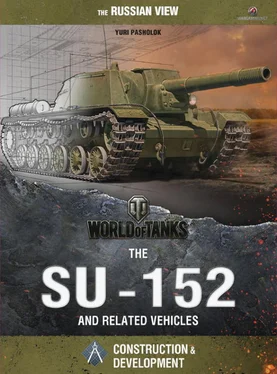5. The vehicle’s dimensions fit within loading gauge “0”, and its corners come close to the limits for structure gauge “0”. {5} 5 TsAMO RF, collection 81, series 12104, file No. 147, p. 46.
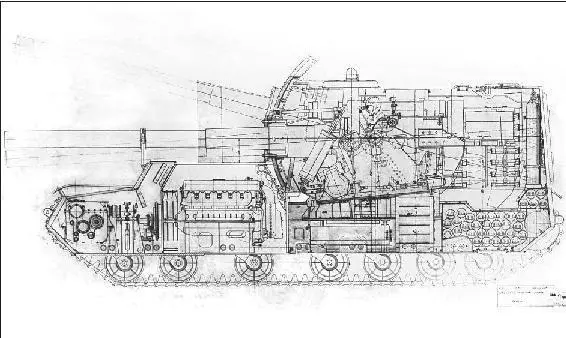
Cross-section of SP gun 212 (ASKM).
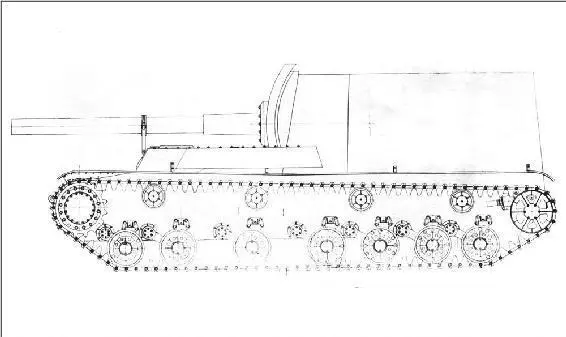
Factory drawing of bunker buster 212 (V. Len).
The situation caused a heated debate in two directorates. Development of SP guns was overseen by the GAU, and the GBTU was frequently at odds with the artillerymen. In the case of the 212, the GAU oversaw work on the gun, and GABTU was in charge of the chassis. The artillerymen looked for various ways to solve this problem, as eloquently stated in a letter that M. M. Zhevannik, head of the second department of the GAU’s Artillery Committee, wrote on December 26, 1940, to Military Eng. 1st Class Komarov, chief of the Field Artillery Directorate’s Science and Technology Department (NTO UVNA):
Since vehicles are the responsibility of the NTO UVNA, the conclusion and report on the Kirov Factory’s letter should be written by NTO UVNA.
I hereby provide the opinion of the Artillery Committee’s second department on the issue:
1. Based on its preliminary engineering analysis, the Kirov Factory believes that the combat weight of the vehicle with the BR-2 gun will be approximately 65 tonnes instead of the 55 tonnes stipulated in the draft operational requirement.
In view of the fact that the maximum weight of a vehicle that may be loaded on a railcar must not exceed 60 tonnes and the weight of the vehicle without munitions, crew, and fuel will be approximately 60 tonnes, the Artillery Committee’s second department believes that a deviation from the specified weight (55 tonnes) can be accepted if a weight reduction of 2 tonnes is achieved by slightly decreasing the thickness of the turret armor.
A smaller weight reduction can be achieved by replacing the BR-2 with the BR-13 gun.
2. Without examining the design drawings, the Artillery Committee’s second department is unclear about the reason for reducing the traverse rate as compared with the BR-2 field gun.
3. We believe that the BR-2 laying devices should be used with just the attachment points changed.
In order to be capable of firing at depression angles on the order of -15–20° and retaining air in the recuperator while moving down a slope, we suggest that the Kirov Factory lengthen the tubes in the recuperator. The increased tube length must be such that air is still reliably retained at elevation angles on the order of 35°.
4. The 8° (+/-4°) traverse angle should be considered satisfactory.
5. The reduction in the number of rounds in the combat load from 50 to 47 is consistent with the draft operational requirement. {6} 6 TsAMO RF, collection 81, series 12104, file No. 147, pp. 43–44.
All of the Kirov Factory’s suggestions were eventually accepted. According to the GABTU’s report on the project, assemblies for the 212 had been manufactured by January 1941. A manufacturing plant had also been developed for the SP gun and drawings had been sent to the Izhor Factory for manufacturing the hull. By that time, a total of 1.5 million rubles had been spent on the project. Work on the SP gun was delayed because the T-150 and T-220 had a higher priority, and there were also problems of a different nature. As of February 24, 1941, work on the “self-propelled object” had reached the following stages:
Drawings of parts, units, and assemblies are complete. Orders to manufacture the parts have not been sent to the shop and will not be sent until March 1, 1941. The hull and turret are in the production stage at the Izhor Factory and will be complete only on March 1, 1941.
The hull for the first SP gun was not received from the Izhor Factory until March 5, 1941. According to the report, assembly was delayed due to lack of parts. Meanwhile, a situation was developing at the Kirov Factory in the spring of 1941 that caused the 212 to gradually fade into the background. The Kirov Factory had received an urgent order to develop a heavy tank, which inherited the designation KV-3 from the T-150. This project, which received the factory designation 223, was developed from the T-220. The thickness of the glacis armor was increased to 120 mm, and it was given a new turret with the ZIS-6 107 mm gun. The combat weight of the KV-3 was estimated at 68 tonnes. Development of this tank was driven by intelligence about the appearance of a German heavy tank. The Kirov Factory also began designing the KV-4 and KV-5 heavy tanks. The combat weight of the KV-5 was 100 tonnes. All this was in addition to the fulfillment of plans for two other projects that were being pushed, the KV-1 and KV-2. With this workload, progress on the 212 came to a standstill beginning in the second half of March 1941. In both April and May 1941, progress reports on the “self-propelled gun based on the KV chassis” reflected “no change.”
The GABTU had somewhat different plans for the bunker buster. According to a GAU report on development work dated May 22, 1941, plans called for manufacturing 12 type-212 SP guns, with an estimated cost of 300,000 rubles for the BR-2 system. Somewhat later, the number of SP guns was cut back to 10 vehicles, and the cost of a system grew to 1 million rubles.
The decree “On Self-Propelled Artillery” issued May 27, 1941, by the Council of People’s Commissars and the Central Committee clearly demonstrates the serious nature of the plans for manufacturing an SP gun with the BR-2 gun. That document, which must have been signed by Joseph Stalin, said the following:
The Council of People’s Commissars of the USSR and the Central Committee of the All-Union Communist Party (Bolshevik) decree that:
I. The inventory of the Red Army shall include the following types of self-propelled guns:
1) SP bunker busters;
2) SP tank destroyers;
3) Assault artillery for supporting the mechanized infantry;
4) SP antiaircraft guns.
It shall also have special self-propelled vehicles for transporting ammunition and motorized infantry soldiers.
II. The following steps shall be taken to acquire these arms:
1. Bunker busters.
To carry out the decree of the Council of People’s Commissars of the USSR and the Central Committee of the All-Union Communist Party (Bolshevik), the People’s Commissariat of Heavy Machine Building shall deliver self-propelled 152 mm BR-2 guns on KV-3 tank chassis to the People’s Defense Commissariat during the following months:
August: 1 unit
September: 2 units
October: 2 units
November: 3 units
December: 2 units
shall provide the Kirov Factory hulls and armor parts for these vehicles one month prior to delivery of the completed vehicles to the People’s Defense Commissariat.
Within 20 days after receiving the first vehicle, the People’s Defense Commissariat shall subject it to testing. {7} 7 TsAMO RF, collection 38, series 11355, file No. 190, pp. 49–50.
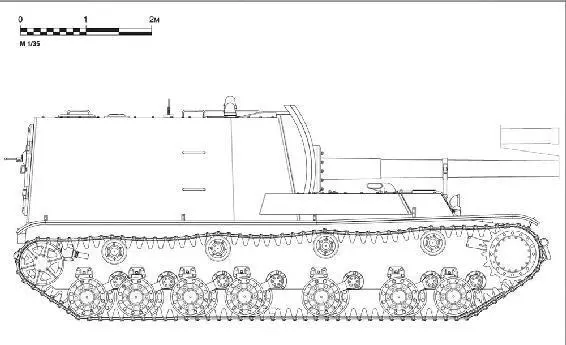
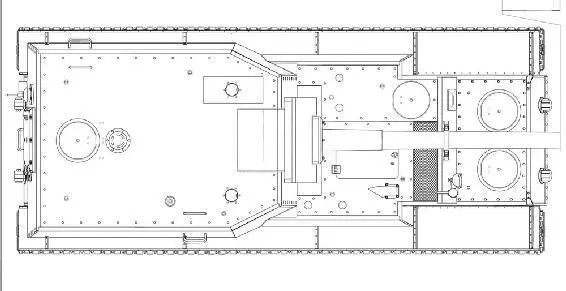
Bunker buster 212, 1:35 scale drawing.
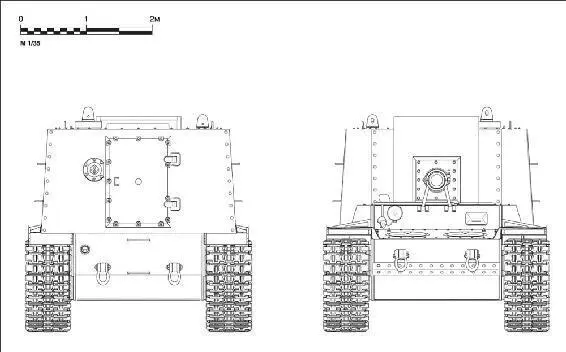
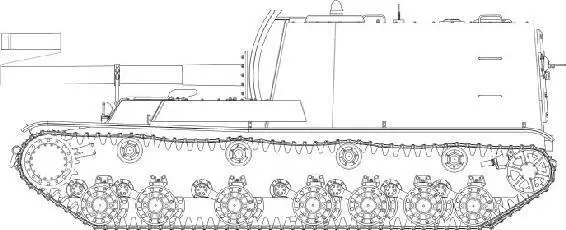
Bunker buster 212, 1:35 scale.
It should be noted that reference to the KV-3 as the base chassis did not mean the self-propelled gun had undergone a radical change. As mentioned above, the KV-3 was developed from the T-220, so the chassis change was basically a paper exercise. The May 26, 1941, operational requirement No. 1397 “for design of a 152 mm self-propelled gun” said as much. Here is a short quote from that operational requirement:
Читать дальше
